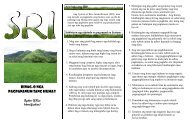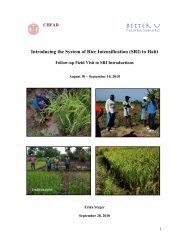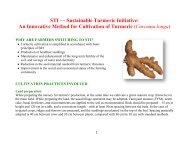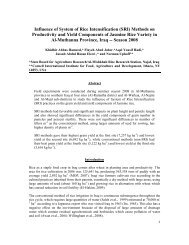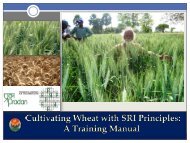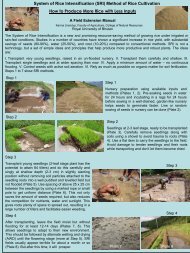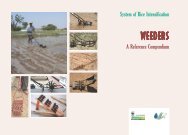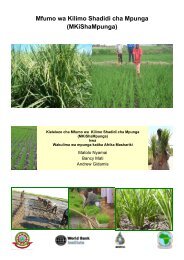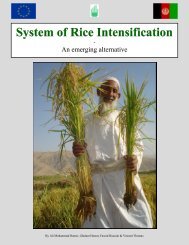EFFECT OF THE SYSTEM OF RICE INTENSIFICATION (SRI) ON ...
EFFECT OF THE SYSTEM OF RICE INTENSIFICATION (SRI) ON ...
EFFECT OF THE SYSTEM OF RICE INTENSIFICATION (SRI) ON ...
You also want an ePaper? Increase the reach of your titles
YUMPU automatically turns print PDFs into web optimized ePapers that Google loves.
9.5.1. Seeds and varieties<br />
The amount of seeds used for <strong>SRI</strong> versus traditional growing was very significant: farmers only<br />
used 0.02 kg seeds m -2 compared to their traditional fields where they used 0.63 kg seeds m -2<br />
respectively. The seeds are not directly sown in the fields but in small nurseries where after the rice<br />
seedlings are transplanted. These results are in accordance with <strong>SRI</strong> practices in other countries.<br />
Menete et al. (2008) used 0.1 kg of seed per m 2 for trials in Mozambique and Satyanarayana et al.<br />
(2007) report that <strong>SRI</strong> farmers in India are able to reduce the seeding rates (20% of conventional<br />
use) with app. 0.0005 kg to 0.001 kg m -2 . Anthofer (2004) reports that Cambodian <strong>SRI</strong> farmers<br />
were able to reduce seeding rates from 90 kg ha -1 30 kg ha -2 by converting to <strong>SRI</strong> corresponding to<br />
0.009 kg ha -1 to 0.003 kg ha -1 respectively.<br />
Most of the identified rice varieties used by farmers were traditional – 36 different (see Appendix<br />
E) with only few being modern introduced varieties such as IR varieties. The farmers use in average<br />
four different varieties, often mixed within the same field. Farmers use the same varieties for both<br />
<strong>SRI</strong> and their traditional fields. Koma (2002) states that local varieties perform very well with <strong>SRI</strong><br />
practices and even though modern cultivars give higher yields, consumers still prefer local varieties<br />
hence market prices are higher. Local varieties have probably adapted to the lowland rainfed<br />
conditions which according to Wade et al. (1999) are very alike in all lowland rainfed rice systems<br />
and often are tall as submergence comes and goes very unpredictable. Prasad (2006) evaluates that<br />
<strong>SRI</strong> can be seen as a variety independent system which does not seek higher yields from growing<br />
different varieties. Kabir & Uphoff (2007) did however find from <strong>SRI</strong> FFS in Myanmar that most<br />
popular non <strong>SRI</strong> methods included selecting better genetic material and higher quality seeds which<br />
resulted in 18% and 28% increase in yield respectively (performed with <strong>SRI</strong>).<br />
The green revolution only introduced new varieties for dry season production in Cambodia and only<br />
few varieties for the wet season (Koma, 2008) meaning few varieties for the rainfed systems. The<br />
green revolution had a great impact on irrigated areas with good soil with fertilizer responsive<br />
varieties but in indigenous systems trials have often tried to replace and not complement the<br />
farming systems which were not successful (Greenland, 1997). However with future breeding on<br />
rainfed rice the possibility of varieties performing well with rainfed conditions might prove very<br />
efficient with <strong>SRI</strong> practice.<br />
52



